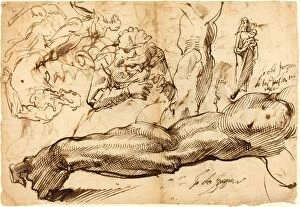1592 Collection (page 8)
"1592: A Year of Art, Literature, and Historical Significance" In the year 1592
All Professionally Made to Order for Quick Shipping
"1592: A Year of Art, Literature, and Historical Significance" In the year 1592, the world witnessed a plethora of remarkable events and creations that left an indelible mark on history. One such luminary figure was Michel de Montaigne (1533-1592), whose philosophical musings continue to inspire generations. His profound insights into human nature and self-reflection have stood the test of time. Meanwhile, Jacques Callot (French, 1592 - 1635) emerged as a prominent artist during this era. His original map depicting the Battle of Lepanto in October showcased his exceptional talent for capturing historical moments with intricate detail. Another masterpiece by Callot titled "The Revenge of the Peasants" highlighted his ability to depict societal struggles through art. Artistic excellence extended beyond France as well. David beheading Goliath became a subject that captivated artists across borders, resonating with audiences worldwide due to its timeless tale of triumph over adversity. Honore De Luynes made significant contributions during this period too. His endeavors shaped cultural landscapes and left lasting legacies for future generations to cherish. Turning our attention towards England, we find ourselves immersed in The Charing Cross Region about 1592 lithograph—a visual gateway into Elizabethan London's bustling streetscape. Additionally, Hamonds Map from 1592 offers us a glimpse into cartography's evolution while showcasing geographical knowledge at that time. Even Japan had its own artistic representation reflecting historical events; a Japanese artist depicted Japan's invasion of Korea in 1592 through their lithographic creation titled "The shadow of a coming event. " This artwork serves as both an artistic marvel and a reminder of past conflicts between nations. Closer to home lies Mayoral Door-Posts in Norwich from 1592—an engraving capturing architectural beauty while symbolizing civic pride within local communities.



















